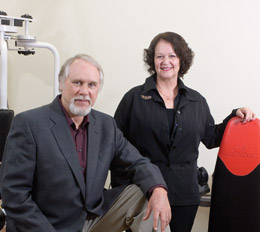Insuring fitness
Philadelphia Insurance teams up with West Coast specialty firm
By Elisabeth Boone, CPCU
You don’t have to be a fitness buff to know that health and wellness are big business in the United States. From aerobics to yoga, Americans are thronging to gyms, clubs, and studios in search of physical and emotional health.
The facilities that fitness seekers visit run the gamut from small home-based personal trainers to mega-gyms operated by national chains. Differences in size and location notwithstanding, all fitness-related enterprises have one thing in common: exposures to loss.
Evaluating and addressing those exposures requires the skill, focus, and discipline of an experienced specialist. Those qualities are the hallmarks of the Fitness and Wellness division of Philadelphia Insurance Companies in Solana Beach, California, which specializes in meeting the insurance needs of a wide range of individual instructors and health and fitness facilities. Established in 1984, Fitness and Wellness operates in all 50 states, providing coverage for more than 24,000 instructors, fitness and dance studios, spas, and health clubs.
On the individual side, coverage is available to personal trainers, fitness instructors, Pilates instructors, physical therapists, coaches, yoga teachers, dance instructors, and martial arts instructors. Eligible facilities include health clubs, fitness clubs, Pilates studios, dance studios, day spas, yoga studios, and martial arts studios.
Earlier this year, Philadelphia Consolidated Holding Corporation purchased Fitness and Wellness’ renewal rights, service marks, and the rights related to its risk purchasing group. The transaction combines the specialized expertise of Fitness and Wellness with the strength and reach of the Philadelphia Insurance Companies organization, which consists of two A+ rated insurers, Philadelphia Insurance Company, a nonadmitted property/casualty insurer, and Philadelphia Indemnity Insurance Company, an admitted P-C carrier; Liberty American Insurance Group, a holding company for two Florida-based personal lines insurers; Valley Forge Insurance Brokers, a wholesaler; and Maguire Insurance Agency, Inc., a captive agency.
Eye on synergies
Philadelphia Insurance Companies’ integration of Fitness and Wellness isn’t the insurer’s first venture into the field of health and wellness, says Coleman Henry, senior vice president of commercial lines at Philadelphia Insurance Companies.
“Philadelphia Insurance is very active in the market for health and fitness clubs, sports camps, sports teams, youth soccer leagues, Little League baseball, and pro sports,” Henry says. “Fitness and Wellness has always focused on the individual trainer and the small studio, so it really seemed like a nice fit. When we first started talking with them a couple of years ago, it was clear that they had the individual market nailed as far as processes and efficiencies, and we were experts in writing larger facilities, so we definitely saw some synergies,” Henry comments.
Deborah Grady, former president and co-CEO of Fitness and Wellness Insurance Agency, is now assistant vice president of the division for Philadelphia Insurance Companies. She and co-CEO Jeffrey Frick saw the same synergies—and also recognized an opportunity to perpetuate their agency by joining forces with Philadelphia Insurance. “For about three years, Jeff and I looked for a perpetuation solution for Fitness and Wellness,” Grady says. “We talked with a lot of really great carriers and brokers around the country and concluded that Philadelphia Insurance provided the best synergy and opportunity to perpetuate the business. They were willing to keep our office operating here in Solana Beach, which was important to us. They’ve been our nemesis all these years,” Grady says with a chuckle, “so we decided that if we couldn’t beat them, we’d join them.”
Fitness and Wellness has deep roots in the health and fitness community. The agency was founded in 1984 by Jeff Frick, who at that time was a partner in the Murria & Frick Insurance Agency in Solana Beach. He created and managed the Jazzercise Group’s insurance program and started working with an association of fitness instructors called IDEA Health & Fitness Association. “The purpose of IDEA was to help fitness instructors become better informed about proper instruction techniques and, in conjunction with that, the importance of liability insurance,” Grady explains.
In addition to IDEA, the program is endorsed by the Yoga Journal Benefits Plus, the National Association of Professional Martial Artists, Power Pilates, and several other associations. “Some of these groups are education based, some offer certification programs, others are business oriented, and still others are primarily for networking,” Grady explains.
Grady joined the agency in 1991 as operations manager, where, she says, “I created an infrastructure for internal operations and added a management level to really help grow the program.” In 2001, Fitness and Wellness was spun off from Murria & Frick and became a separate corporation. “I became an owner and assumed the role of president and co-CEO,” Grady says. “I was responsible for managing day-to-day operations, while Jeff focused on developing new programs and partnership relationships.”
Risk purchasing group
In 1998, Fitness and Wellness established a risk purchasing group called the Fitness and Wellness Purchasing Group and filed it in all 50 states. “It was a great way to combine the synergistic and homogeneous qualities of the fitness groups we were already writing,” Grady says. “And it gave us the ability to offer coverages that were better suited to their unique needs, and the pricing and rating factors that considered different types of exposures for different segments, like individual instructors, studios, and health clubs.
“That gave us the ability to create a sophisticated master policy for general liability,” Grady says, “and we’ve also been able to do that outside of the purchasing group on the property side. Each member can be covered as a unique insured, with its own effective date and coverage limits applied per location, so there’s no sharing of policy limits,” Grady explains.
In arranging insurance for health and fitness facilities, by far the greatest exposure is liability, and the Fitness and Wellness program reflects that reality. “Ninety-nine percent of the claims we see are under the comprehensive general liability coverage part,” Grady comments. “Our policy combines general and professional liability to address both aspects of the exposure.”
For individual instructors, obtaining coverage is quick and easy. “An individual can complete a simple application online, provide a credit card number, and have a coverage certificate within a few hours,” Grady explains. “Our goal is to make this system real time, so as soon as the credit card approval comes back from the bank, the applicant will receive an e-mail confirming coverage.” If one or more of an applicant’s responses is improper or incomplete, the system sends back an e-mail explaining that the application will be reviewed by an underwriter. The average application is turned around in less than 48 hours, Grady says, and policy issuance is completed within three days.
The average premium for an insured in this program is $185 per year. “Because of the efficiencies Fitness and Wellness has developed over the years, along with use of the RPG, the rates are very competitive,” Henry remarks. “Where there’s a studio or a group of studios, or a health club or group of health clubs, there’s certainly a role for the agent,” he says.
“We currently broker business for hundreds of agents,” Grady notes; about 20% of the agency’s business is placed on a brokerage basis.
In addition to general and professional liability, Fitness and Wellness offers commercial property, business interruption and extra expense, workers compensation, and employers liability coverages as well as bonds. The agency publishes an online newsletter that alerts insureds to exposures and offers risk management techniques. A recent issue emphasized the importance of using well-written, carefully administered customer waivers in conjunction with a comprehensive program of insurance and risk management.
A look at the market
How competitive is the market for the classes of business written by Fitness and Wellness?
“Outside the risk purchasing group, we’re looking mainly at a commercial lines package policy for health and fitness club-type exposures, including facilities that are housed in hotels for the use of guests,” Henry explains. “The market is competitive, but not to the point that there are going to be 50 markets showing up with a quote. Usually when it’s time to put a quote on the table, there are three or four significant players.
“Availability differs in the sense that not all of the markets are willing to write the abuse and molestation coverage, and not all are willing to write professional liability for trainers,” Henry continues. “Those are two coverages that we do provide.”
Grady points to another way in which Fitness and Wellness distinguishes itself from competitors. “We have the ability to write multi-use facilities, such as a high-end facility that has a restaurant or a spa or other ancillary services.”
Among both individual instructors and small studios, Grady comments, the loyalty factor is high. “On the club side, the individual clubs don’t shop around a lot,” Henry adds. “Where we see a lot of shopping going on is among the big chains. Many of them are publicly held, so they have to shop. Our retention in that line is about 93%.”
The scope of the market is broad, Grady observes. “We did a study, and we found that between the small fitness, yoga, and martial arts studios, there are about 60,000 potential insureds out there.” Fitness and Wellness pursues business through a multi-channel effort that includes attending association meetings and trade shows, advertising in professional journals, and outbound Internet and telephone marketing. Last year the agency hired a producer to follow up on leads generated through these channels.
Challenges ahead
“Our major challenge is how to be cost effective and keep premiums low,” Grady remarks. “We’re looking at new ways to drive business in and have a sales force in place to go after prospects. On that score, we’ve just put our toe in the water, and it’s been incredibly successful. When we call on studios in our middle market niche, we’re finding that they’ve never really been marketed to before,” Grady says. “They’re thrilled to hear that someone wants to help them find what they really need. Our closing ratio has been extremely high; we’re closing between 60% and 70% of the business we quote. We think we have a great opportunity here.”
On the larger health club business, Henry says, “Our hit ratio for 2006 was 64% on a bound to quoted basis, and our renewal retention was almost 95%.” On the smaller health clubs it insures, Grady says, Fitness and Wellness enjoys about 90% retention; for studios, the rate is in the mid-80s, and retention averages in the low 70s for individual instructors, primarily because they tend to come and go in the business.
Another challenge, Henry points out, is posed by the changing face of the business in the market for larger health and fitness facilities. “The stand-alone, individual-proprietor health and fitness facility is going somewhat by the wayside,” he comments. “A lot of them are either getting bought by large conglomerates or just going out of business.”
Of the smaller facilities that do keep their doors open, Henry says, many are becoming physical therapy or sports medicine centers and are also offering personal training, Tai Chi, yoga, Pilates, massage, and lymphedema treatment.
“We tend to look at these as good risks,” Grady says, “because they’re doctor-directed for the physical therapy side. We’ve done well with these facilities.”
The growth in popularity of such multi-use facilities, Henry observes, “also drives the growth of the Fitness and Wellness RPG for individual instructors.”
Building on their individual strengths and capitalizing on their synergies, Fitness and Wellness and the Philadelphia Insurance Companies are determined to become the go-to market for the expanding health and fitness industry. *
For more information:
Fitness and Wellness
Phone: (800) 395-8075
Web site: www.fitnessandwellness.com |
|
Click on image for enlargement |
 |
| |
Jeffrey Frick founded Fitness and Wellness in 1984, and served as co-CEO with Deborah Grady. Fitness and Wellness became part of Philadelphia Insurance Companies earlier this year.
|
| |
“Jeff and I looked for a perpetuation solution for Fitness and Wellness. We talked with a lot of really great carriers and brokers around the country and concluded that Philadelphia Insurance provided the best synergy and opportunity to perpetuate the business.”
—Deborah Grady |
|
| |
 |
| |
Overseeing the Solana Beach, California-based Fitness and Wellness division, Philadelphia Insurance executives from left are Michael P. Kuhney, Vice President/Commercial Lines Underwriting; James J. Maguire Jr., President/CEO; Bryan R. Luci, Regional Vice President; and Timothy J. Maguire, Senior Vice President. |
| |
 |
| |
Jeff and Deborah meet with Body Quest Fitness Owner and personal trainer Kristin Fergasse (center). |
|


